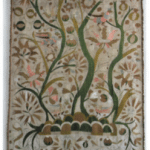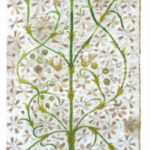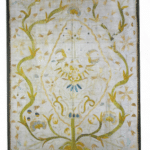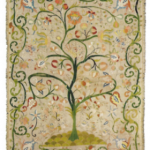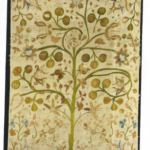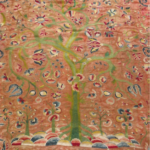VEGETALISTS
Tree
The quilts with the "tree of life" show very little variation among themselves. His model is said to have been the pattern of an Indian palampore (printed cotton cloth), a pattern that, with time, integrated some figurations next to the characteristic "scaled" mound of earth from which the tree appears. Two types of these figurations are known: small roosters, known in local slang as galrichos, numbering four or six, and one or three riders. To welcome them, the initial design was modified, interrupting the stems of the bushes that grew next to the tree and parallel to its trunk, which are now suspended, making room for the new elements.
The branches of the tree extend in all directions of the quilt field, with fruits and flowers of various designs arranged on them, but always occupying the same relative positions. Just above the center of the quilt the branches define a cartouche that hosts a bird. At approximately the same height you can also see two little birds, one on each side of the tree.
In some cases you see some windings that outline a bar going around the entire field, but these windings can be missing. The corners are highlighted by an impressive "lotus flower," which opens toward the center of the quilt and whose stem is inscribed in its bisector.
To these quilts, all very similar and where you never find carnations, are added others where the tree appears drawn in a more free and careless way, and there is even a case where you can see several trunks instead of a single one. It is on these trees that the open carnations appear, characteristic of the later production, probably made in the Castelo Branco region.
Whatever the design of the tree there are elements that must be maintained, namely the mound of earth in "scales" and the filling of the field with branches laden with flowers, fruit, and where birds may or may not appear. In more contemporary designs more stylized flower or fruit motifs are acceptable.
Flowers
Flowers are one of the motifs that most characterize the quilts of Castelo Branco. They present, as you would expect, varied designs, some more identifiable than others. In fact, since its probable models are either Chinese or Indian pieces, if there are flowers that are easy to identify (lotus flowers, papyrus flowers, chrysanthemums, peonies) there are others of fanciful design that are difficult to name. Add to this panoply European flowers such as myosotis or lilies.
With the exception of a few cases such as peonies, embroidered with feather stitch, or myosotis embroidered with hue stitch, the flowers are always embroidered with Castelo Branco stitch, which can, however, be accompanied, in small details, by other stitches.
Carnations
In the Bordado de Castelo Branco the carnation is the dominant flower, having become the icon par excellence of this production.
Compact carnations
On the quilts from the Lisbon Workshop, made in the late 17th century, the carnations are always depicted in cut, with calyx and compact corolla. They are usually embroidered in taupe, but there are cases where they are embroidered with "full beaks". They were widely used in embroidered quilts in the 1940s and 1950s.
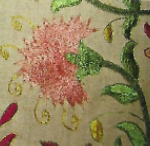
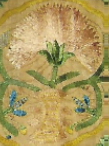
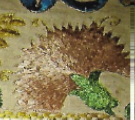
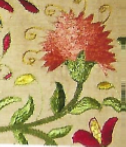
Rich Carnations
In more carefully designed pieces there is another, rarer type of carnation, which we call "rich carnation". In this one, the design is more worked out. You can see the chalice holding a "bulb" from which petals emerge, with their respective beak trim. However the petals are always worked in two colors. In some cases, of more complex and exquisite design, between the "bulb" and the petals is a crown of spikes.
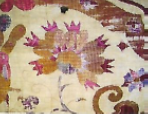
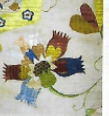
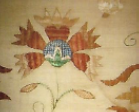

Open Star Carnations
In the later "open carnation" quilts, these have great expression, with the existence of several sub-types being noted: simple open starred, open profiled starred, and mixed open starred.
In simple open star carnations, the flowers are flattened. There is no calyx, but rather a large corolla from which petals emerge, varying in number (from five to twelve), separated from each other and also topped with the same type of beaks. The corolla can be filled with a very simple net, White Castle stitch or twisted net.
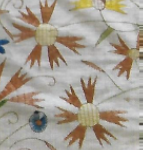
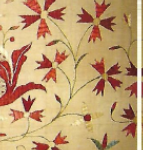
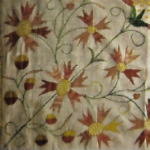
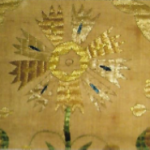
There are also espaliered carnations that are shown in profile - Open star carnations in profile, as they always show a calyx with two or more sepals, bordered in the same color as the stem.
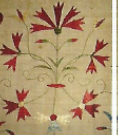
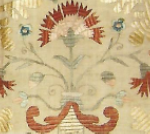

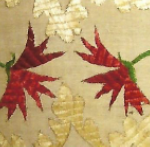
Mixed Open Carnation
The mixed starry open carnations also appear starry, but in the space corresponding to the corolla, you can also see a chalice and other figurations such as stylizations of flowers or buds.
The number of petals varies between three and seven, all topped by beaks, also variable in number, three being the most common.
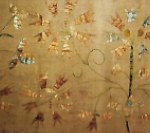
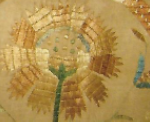

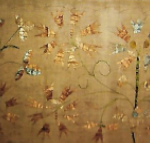
Lotus Flower
The lotus flower appears in both the most erudite and the most popular pieces. Over time, its design loses definition, moving away from the more erudite models.

